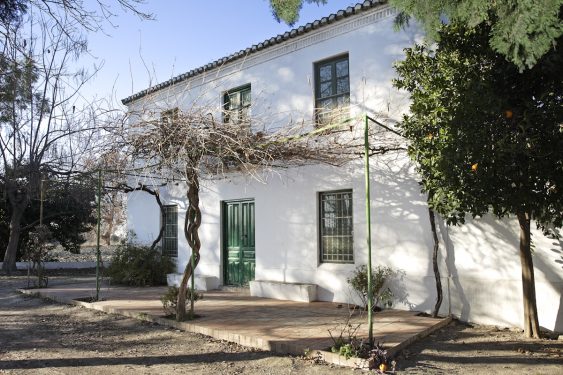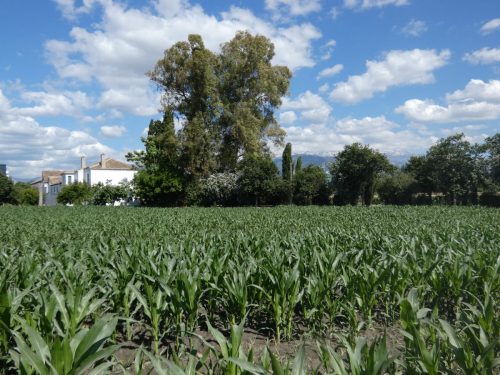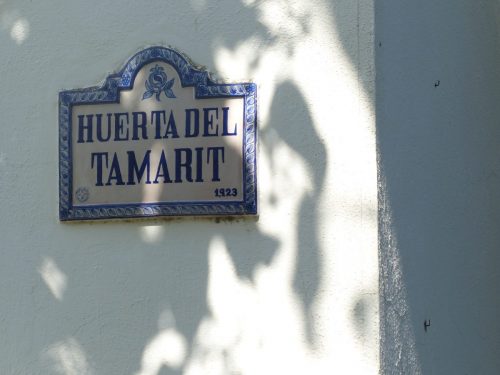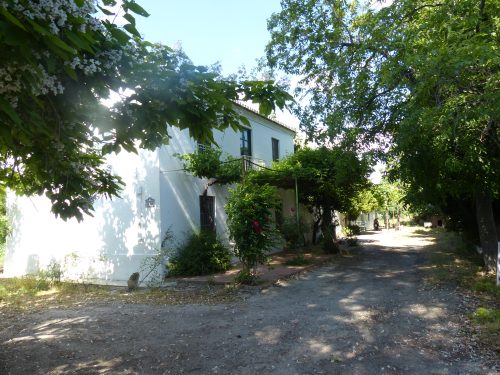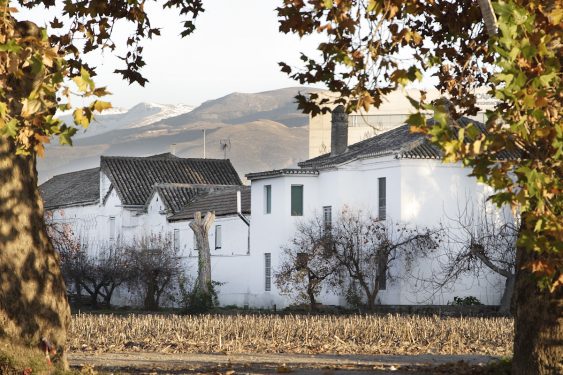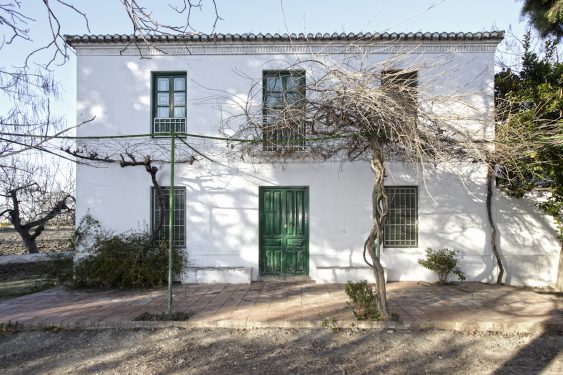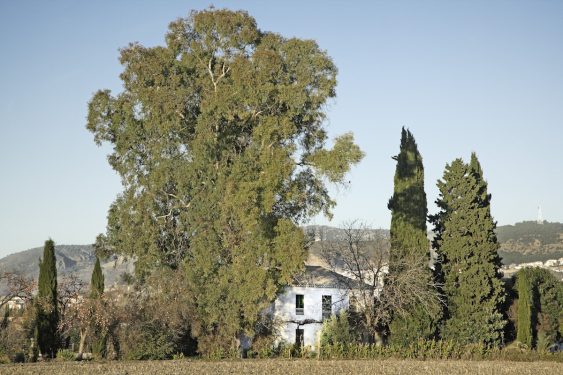The country house of Francisco García Rodríguez and his daughters that inspired Federico’s Divan del Tamarit. It is private and only the surroundings are accessible.
Before Don Federico García Rodríguez bought the Huerta de San Vicente (San Vicente Farmhouse), where Federico García Lorca spent his summers and wrote a substantial part of his adult work from 1926 onwards, he was interested in another similar property located nearby, the Huerta del Tamarit (Tamarit Farmhouse) (Garden of Dates, in Arabic), five hectares of irrigated land next to the Genil, in the Pago del Jaragüi or Jaragüit Bajo, according to the contradictory names of the settlements recorded in the books of the irrigators of the Acequia Gorda (Large Irrigation Channel).
One farm was then only fifteen minutes away from the other on foot. Don Federico, however, preferred at that time, in 1918, to lend it to his brother Francisco, father of Carmen and Clotilde García Picossi. Clotilde, one of Federico’s favorite cousins, would soon after become the owner of the place that gave its name to Lorca’s last book, Divan del Tamarit, written from the second half of the 1930s and published posthumously.
Lorca commented in a letter that his cousin’s orchard had one of the most beautiful addresses in the world: Huerta del Tamarit, term of Fargüi, Granada. “Cousin,” Federico told Clotilde, “your farmhouse is a collection of postcards.”
In 1918, Don Federico had not yet conceived the idea of interrupting the periodic stays in the house of Asquerosa (Disgusting), coinciding with the threshing season, and acquiring a country house near Granada, so he let the opportunity pass him by. Francisco García Rodríguez built the main house in 1923 and then a smaller one for the caretakers.
From the purchase of the Huerta de San Vicente, the comings and goings of the family from one estate to another was constant. They were so twinned one property with the other that their cadastral denomination overlapped to the point of creating a nominal misunderstanding. There are those who place the Huerta de San Vicente in the term of Jaragüi or Fargüi, the same as the Huerta del Tamarit, when in fact the first was paid for by Arabial. In any case, the names share the same euphonic beauty with Arabic endings. Lorca commented in a letter that his cousin’s farmhouse had one of the most beautiful addresses in the world: Huerta del Tamarit, term of Fargüi, Granada. Federico used to walk to his cousin Clotilde’s house frequently to savor her ‘arriero’ rice, “Cousin,” Federico told Clotilde, “your farmhouse is a collection of postcards.”
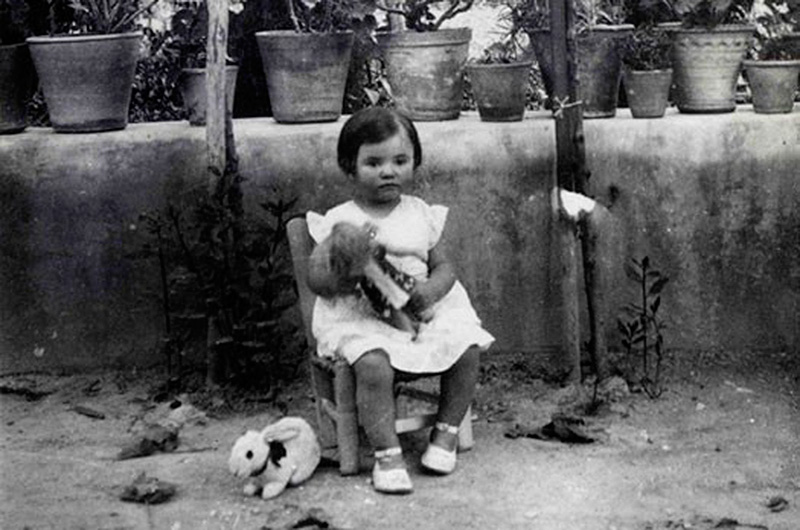
It is difficult to specify which poems of Divan del Tamarit were written in the Huerta de San Vicente and which in the Huerta del Tamarit, especially because the collection, although concentrated in 1934, was composed over a very long period. In the summer of 1931, Lorca had already written the Casida of the Outdoor Dream and the Ghazal of the Bitter Root. On the ship that brought him back from Argentina he wrote at least two more ghazals and a casida. According to his friend Eduardo Blanco-Amor, who resided in the Huerta de San Vicente in the summer of 1934, he saw him writing “in a cafe on Zacatín Street” the Ghazal of the Morning Market. As Blanco-Amor himself wrote in 1937, trying to settle the ambiguity of the names, “the Huerta del Tamarit was, according to the erudition or imagination of Federico, the Moorish name of the Huerta de San Vicente, shaded by laurels, illuminated by cherry trees and reflected by irrigation channels where the poet spent his summers”.
The construction of the Granada ring road in the eighties divided both estates and turned the entire agricultural area of the Vega into small unconnected islands. San Vicente was integrated into the city and Tamarit on the other side of the highway. Taking the route from one farmhouse to another is now a complicated and even dangerous task due to the traffic and the constant unevenness of the ground. The Huerta del Tamarit is currently privately owned.
Lorca’s first indication of The Divan del Tamarit was in 1934 after a reading of Yerma at the Casa de los Tiros in Granada, attended by the architect Francisco Prieto-Moreno, the professor Antonio Gallego Burín and the Arabist Emilio García Gómez, among others. From that meeting came the determination to publish Divan in the publishing house of the University of Granada with a foreword by the Arabist.
García Gómez fulfilled his commitment and left an introduction ready, which later appeared randomly in The Moor’s Chair and New Andalusian Scenes where he recounts the origin of the failed book and comments on Lorca’s poems. “Lorca told us then that he had composed, in homage to these ancient Granada poets, a collection of qasidas and ghazals, that is, a Divan, which would take the name of an orchard of his family where many of them were written,” recalls García Gómez.
Clotilde García Picossi, the cousin who owned the Huerta del Tamarit, was seven years older than Lorca although she maintained a close relationship with him dating back to their childhood days in Fuente Vaqueros. Clotilde boasted of being the inducer of Federico’s first appearance in a theater. It was during the performance of The Joy of the Garden, in which Clotilde, at the age of ten, appeared holding Federico’s hand “dressed as a little gypsy”. “People watched us from the rooftops. We already gave sessions for money and everything. In Fuente Vaqueros many people loved the theater. And the García family were all very fond of theater, because they played the guitar and sang very well,” he recalled.
Clotilde inspired her cousin to write some famous scenes for plays. One of them, the best known, is The House of Bernarda Alba when Adela, fed up with mourning, puts on a beautiful green dress to feed the chickens. “It was a prison to wear mourning. I had those beautiful clothes. And I couldn’t wear that dress for the first time. So I decided to put it on with all the beads I had. With many ornaments, many things, colored shoes. I got dressed and went out to the barnyard, peep, peep, peep! so that at least the hens could see me. Since I didn’t want to go out in the street…”, she recalls.
The whole environment of the orchards linked to García Lorca is supported by extensive references in historical texts. Góngora, in a romance, in the sixteenth century, writes: “Y el Jaragüi donde espiran [And the Jaragüi where the fresh valleys exhale] / dulce olor los frescos valles [a sweet smell]”.
It also appears in the general Ballads: “Una parte de la Vega [“A part of the Vega] / que el Genil y Darro bañan [that the Genil and Darro bathe] / cuyas aguas enriquecen [whose waters enrich] / el Xaragüi de Granada”. [the Xaragüi of Granada”].
In Lope de Vega’s tragicomedy Peter the Coalman these verses appear: “Moros sobre cautivas [“Moors on captives] / del Jaragüí de Granada” [of the Jaragüí of Granada”].
The historian Bermúdez de Pedraza called Jaragüí the whole extension of the Vega of Granada.
Por las arboledas del Tamarit
[Through the groves of the Tamarit]
han venido los perros de plomo
[the dogs of lead have come]
a esperar que se caigan los ramos,
[waiting for the clusters to fall,]
a esperar que se quiebren ellos solos.
[waiting for them to break on their own.]
El Tamarit tiene un manzano
[The Tamarit has an apple-tree]
con una manzana de sollozos.
[with an apple of sobs.]
Un ruiseñor apaga los suspiros
[A nightingale gathers sighs]
y un faisán los ahuyenta por el polvo.
[that a pheasant chases through the dust.]
Pero los ramos son alegres,
[But the clusters are happy,]
los ramos son como nosotros.
[the clusters are like us.]
No piensan en la lluvia y se han dormido,
[They are not thinking of rain and have gone to sleep,]
como si fueran árboles, de pronto.
[suddenly, as if they were trees.]
Sentados con el agua en las rodillas
[Sitting with the water up to their knees,]
dos valles esperaban al otoño.
[two valleys were waiting for autumn.]
La penumbra con paso de elefante
Dusk with elephantine tread]
empujaba las ramas y los troncos
[was pushing the branches and tree trunks.]
Por las arboledas de Tamarit
[Through the groves of the Tamarit]
hay muchos niños de velado rostro
[there are many children with veiled face]
a esperar que se caigan mis ramos,
[waiting for my clusters to fall,]
a esperar que se quiebren ellos solos.
[waiting for them to break on their own].
- Francisco García Lorca. Federico and his World. Alianza Tres. Madrid, 1990.
- Jesús Ortega. Album. Huerta de san Vicente. Granada 2015.
- Antonio Ramos Espejo. García Lorca in Fuente Vaqueros. Diputación de Granada, 2007.
- María José Merlo Calvente. For an edition of The Divan del Tamarit.
- Lorca´s location
- Tamarit Farmhouse
- current location
- Tamarit Farmhouse
- ADDRESS
- Callejón de Nogales
- DETAILS OF THE VISIT
The Tamarit Farmhouse is a privately-owned property and only the outside can be visited.
